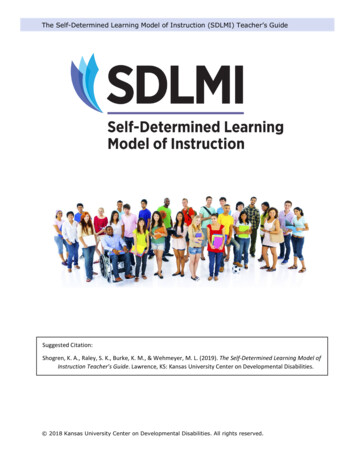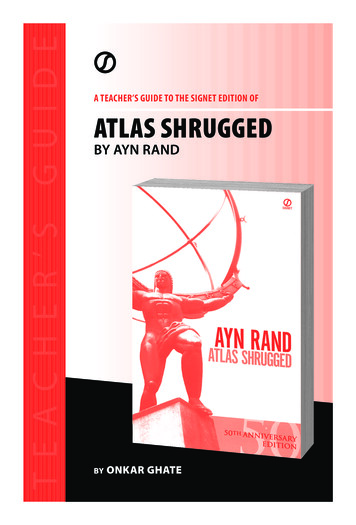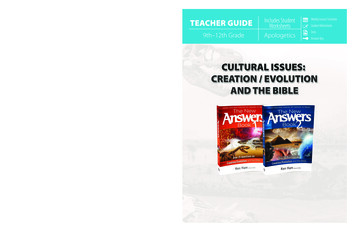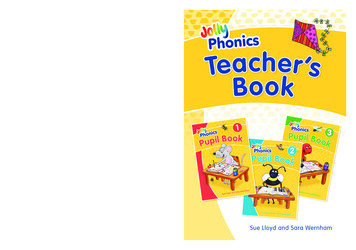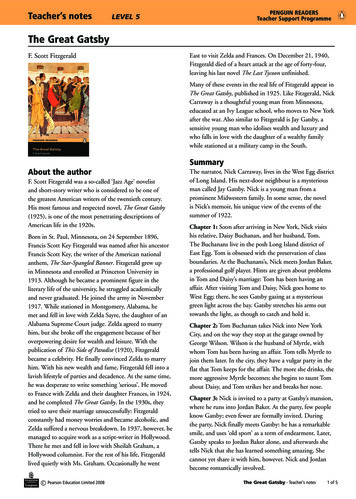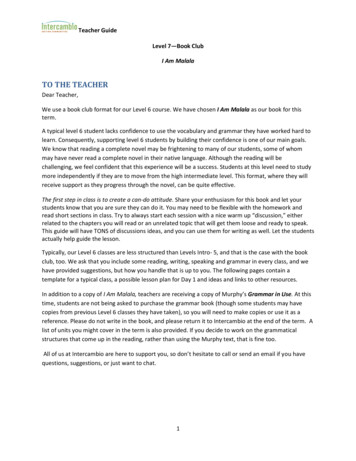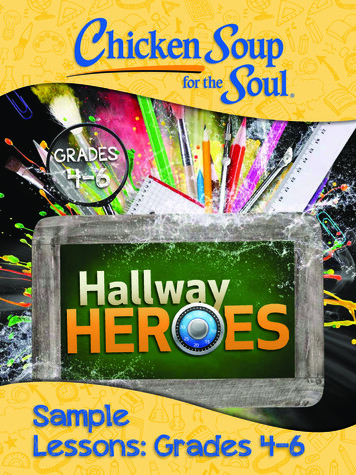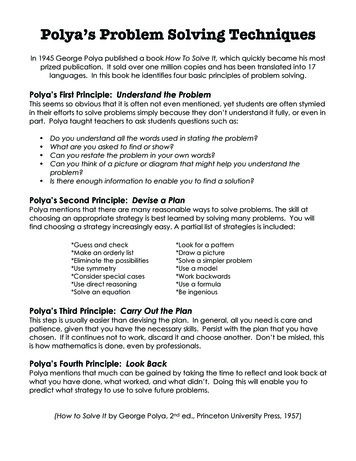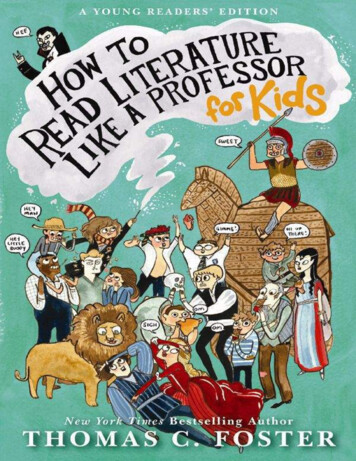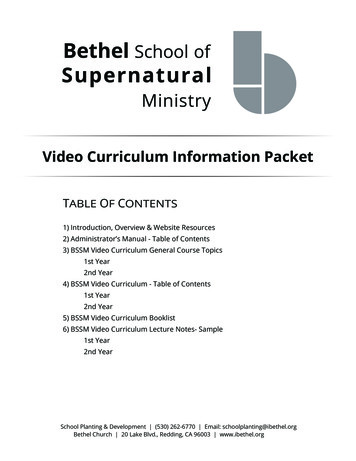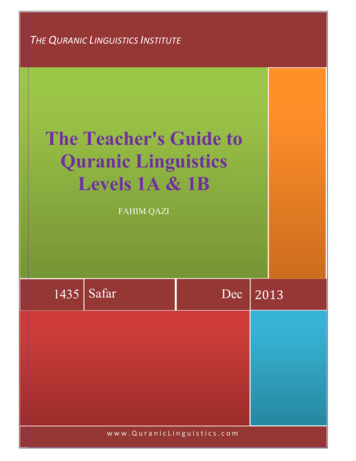
Transcription
THE QURANIC LINGUISTICS INSTITUTE TheThe Teacher's Guide toQuranic LinguisticsLevels 1A & 1BFAHIM QAZI1435 SafarDec 2013www.QuranicLinguistics.com
š Ï ϑÏ yn èy 9ø # UÅ ‘u ! ‰ß ϑô sy 9ø # ΟŠÏÉΟŠmÏ § 9# uÇ Ηu q § 9# !« # ΟÉ ¡ó 0ÎΟŠ ِ ﰒ اﳊﻤﺪ ﷲ اﻟﺬي ﺻﺮف اﻵ ِ ﻳﺎت ﺻﺮﻓًﺎ وﻋﻠّﻢ اﻟﺒﻴﺎ َن وﻧﺰل اﻟﻘﺮآن ﺎ ﻠﻤ ﻋ ّّ ًَّْ ﺎ ﻋﻠﻴﻪ أﻓﻀﻞ اﻟﺼﻼة ﻲ ﻧﺒﻴ ﳏﻤﺪ اﻟ ُﻘَﺮِﺷ ّ ً ُﻣ ْﻌﺮﺑًﺎ ﻋﻠﻰ أﻓﺼﺢ اﻟﻌﺮب ﺑﻼﻏﺔ وأﰎّ اﻟﺘﺴﻠﻴﻢ وﻋﻠﻰ آﻟﻪ وﺻﺤﺒﻪ أﲨﻌﲔ ِ ِ ُ ُ ِ ِ QuranicLinguistics.comArabic with Quran, Quran with ArabicCopyright 2013 by Fahimuddin Fahmy QaziAll Rights ReservedNo part of this book may be used or reproduced in any manner whatsoever withoutprior written permission from Fahimuddin Fahmy Qazi, except in the case of briefquotations embodied in critical articles and reviews. ﻃﺒﺎﻋﺔ ﺷﺮﻛﺔ ﻟﻮﻟﻮ اﻷﻣﲑﻛﻴﺔ ﺟﻤﻴﻊ ﺣﻘﻮق اﻟﻄﺒﻊ ﻣﺤﻔﻮﻇﺔ ﻟﻠﻤﺆﻟّﻒ ﳝﻨﻊ ﻃﺒﻊ ﻫﺬا اﻟﻜﺘﺎب أو ﺟﺰء ﻣﻨﻪ ﺑﻜﻞ ﻃﺮق اﻟﻄﺒﻊ واﻟﺘﺼﻮﻳﺮ واﻟﻨﻘﻞ واﻟﱰﲨﺔ واﻟﺘﺴﺠﻴﻞ اﳌﺮﺋﻲ واﳌﺴﻤﻮع واﳊﺎﺳﻮﰊ وﻏﲑﻫﺎ ﻣﻦ اﳊﻘﻮق إﻻ ﺑﺈذن ﺧﻄّﻲ ﻣﻦ اﳌﺆﻟّﻒ ﻓﻬﻴﻢ اﻟﺪﻳﻦ اﻟﻘﺎﺿﻲ Quranic Linguistics Institute1The Teacher’s Guide
Table of ContentsPart One: Unit by Unit Pedagogical Guide5Level 1-A Teaching GuideUnit 1: Tri-literal Verbs: Conjugation & Patterns61. Why Teach Morphology Before Grammar?2. A Bird’s Eye View of Level Onea. Overview of QL1-Ab. Overview of QL1-Bc. Primary Objectives Of Unit 1d. Pre-requisitese. Vocabulary & Exercisesf. Visual Learning3. Lesson Preparation, Delivery, and Evaluation Guidelinesa. How to Prepare for a Lessonb. Basic Guidelines For Delivering Lessonsc. Student-Teacher Interaction Guidelinesd. Post-Lesson Self-Evaluatione. Materials Required for the Coursef. In-Class Resource Checklist4. Primary Objectives of Unit 1 of QL1-A5. A Word Of Caution on Using Technical Terms Prematurely6. Some Things To Remember Before Teaching Unit 17. Explaining The Color Coded Tables In Class8. Explaining the Six DoorsUnit 2: Masdar & Kana211. An 11-Step Approach To Teaching Arabic Morphology ToBeginners2. Primary Objectives Of Unit 23. Some Things To Remember Before Teaching Unit 2 of QL1-AUnit 3: Derivatives271. Why Study Derivatives2. Primary Objectives Of Unit 33. Some Things To Remember Before Teaching Unit 3 of QL1-AQuranic Linguistics Institute2The Teacher’s Guide
Level 1-B Teaching GuideUnit 1: Syntax & Inflection301. Second Language Acquisition: Grammar-Translation Or TotalImmersion2. The Building Blocks of the Arabic Language3. Summary of the Benefits of the Grammar-Translation Method4. Summary of the Benefits of the Total-Immersion Method5. Primary Objectives Of Unit 16. Some Things To Remember Before Teaching Unit 1 Of QL1-BUnit 2: Advanced Tri-Literal Patterns & Conjugation1.2.3.4.37Primary Objectives Of Unit 2Guidelines For Teaching The 10-FormsSummary Of Morphological SemanticsSome Things To Remember Before Teaching Unit 2 Of QL1-BUnit 3: Morphological Semantics431. Primary Objectives Of Unit 3Unit 4: Miscellaneous Topic451. Primary Objectives Of Unit 42. Some Things To Remember Before Teaching Unit 4Quranic Linguistics Institute3The Teacher’s Guide
Part Two:A Deeper Understanding OfThe Quranic Linguistics Curriculum1. P.E.A.K The Four Primary Characteristics of a Successful ArabicLinguistics Curriculum2. Who is Qualified to Teach Quranic Linguistics?3. The Primary Objective of QL4. Overview of QL Series5. Recommended Medium of Instruction6. Suggested Curriculum Layouts College Arabic High School Arabic Elementary/Middle School Arabic Intensive Arabic/Summer Programs7. The Three Primary Disciplines of the Arabic Language8. Components of a Successful Quranic Arabic Program9. Frequently Asked Questions (FAQ)10. Advice On Studying Arabic Abroad11. Teacher Resources12. QL Teacher Training & Certification Program13. Onsite QL Teacher Training Course14. How to make Windows Arabic-EnabledQuranic Linguistics Institute44849505052535759616465666768The Teacher’s Guide
Part OneUnit by Unit Pedagogical GuideThis is an excellent source for the student ofArabic grammar. The order of the exercisesprepares students well for approaching theQur'an, and I've never seen such an expansivelist of Qur'anic excerpts for each specificgrammatical concept.Tammam Alwan, Quranic Linguistics & Arabic teacher,Michigan, USAQuranic Linguistics Institute5The Teacher’s Guide
Unit 1 of QL1-ATri-literal VerbConjugation & PatternsQuranic Linguistics is in a league of its own. Level 1comprises the most comprehensive study of sarf [morphology] Ihave ever seen in one book. This brings the seeminglyimpossible task of vocabulary acquisition well within reach andmakes the student excited about studying the Quran. The studyof nahw [grammar] is undertaken in great detail in level 2,whose indexes alone are priceless collections of information astudent would be hard-pressed to find anywhere else.Before Quranic Linguistics, I thought I hated Arabicgrammar; now, I love it. The organization of the language ismade clear and beautiful. The author has used his experiencelearning and teaching Arabic to design a curriculum that takesa student step by step in a logical progression, with extensivepractice applying the concepts to Quranic verses. The booksare thorough in content, yet designed to be adaptable fordifferent teaching styles. For the time he has spent extensivelyresearching the concepts handed to us in a digestible format inthese books, all students and teachers of Arabic are indebted tothe author, his family, and his teachers.Autumn Allen, Quranic Linguistics teacher (Boston, USA),BA Literature, Yale University; M.Ed. Harvard UniversityQuranic Linguistics Institute6The Teacher’s Guide
Why Teach Morphology Before Grammar?Arabic scholars consider morphology to be one of the primary disciplines ofthe Arabic language. It teaches us word types, patterns, conjugation, derivation andother things. Arabic morphology is unique in the sense that it enables the speaker toderive words based on specific roots and patterns. This unique and powerful featureis something that only Semitic languages share. As far as a beginner is concerned, itshould be the first thing taught because it helps understand and identify the variousforms and types of nouns and verbs which are necessary to put together a sentence(i.e. syntax). Therefore, this level’s primary focus is morphology.Ibn Jinni, the well-known 4th century Arabic linguist, advocates puttingmorphology before grammar. He writes in his authoritative commentary on alMazini's Kitab al-Tasreef:1. اﻟﻮاﺟﺐ ﻋﻠﻰ ﻣﻦ أراد ﻣﻌﺮﻓﺔ اﻟﻨﺤﻮ أن ﻳﺒﺪأ ﲟﻌﺮﻓﺔ اﻟﺘﺼﺮﻳﻒ .it is necessary for the one who desires (to acquire the) knowledge of grammar thathe/she begin with (acquiring the) knowledge of morphology.Dr. Abduhu ar-Rajihi, expresses his agreement by quoting the above statementin his book اﻟﺼﺮﰲ اﻟﺘﻄﺒﻴﻖ .Arabic scholar, Mustafa al-Ghalayini, the author of theadvanced authoritative grammar text, اﻟﻌﺮﺑﻴّﺔ ﺟﺎﻣﻊ اﻟﺪروس , puts morphology as the firstscience on his list of Arabic disciplines. Al-Halabi, the author of the eleven-volumeencyclopedic linguistic exegesis of the Quran, lists morphology as one of thefundamental disciplines of the Arabic language2.In the late 1990s, I had the privilege of taking Arabic/Islamic classes at theZaytuna Institute taught by Shaykh Hamza Yusuf Hanson who is also the founder ofthe institute as well as the Zaytuna College in California. He put morphology beforegrammar by teaching it first. The Shaykh used to say that non-Arabs should beginwith morphology.Therefore, I think it's a mistake to teach students, especially beginners,grammar without developing proper foundations in the basics of Arabic morphology.Since grammar requires strong foundations in morphology, Arabic students shouldundertake the study of Arabic grammar only after they have successfully completedLevel 1-A of the Quranic Linguistics series.In short, learning Quranic linguistics is a three-step process. The first step isArabic morphology, which is like planting seeds into the ground. The second step,Arabic grammar, is like watering the tree until its branches are fully developed. Thethird step, Arabic rhetoric, is the sweet fruit.p8، اﻟﺘﻄﺒﻴﻖ اﻟﺼﺮﰲ Volume 1, p4 ، اﳌﺼﻮن Quranic Linguistics Institute7 اﻟﺪر The Teacher’s Guide12
A Bird’s Eye View of Level OneAs discussed earlier, morphology is one of the most important disciplines ofthe Arabic language and is also the first step in learning Arabic. Thus, six out of theseven units of Level 1 have been dedicated to building foundational skills in Arabicmorphology. One unit has been dedicated towards understanding introductory syntaxand inflection to put the morphology in context.The units have been arranged in such an order that each contains a series oftopics that must be mastered before proceeding onto the next. Thus, it is highlyrecommended that the teacher not alter the tried and tested sequence of the chapters.Overview of QL1-A: Basic Arabic MorphologyUnit 1Basic Tri-literal verbpatterns & conjugationIntroduces simple verbal sentence via verb conjugation withemphasis on three main concepts: اﳌﻔﻌﻮل ﺑﻪ ، اﻟﻔﺎﻋﻞ ، أﻧﻮاع اﻟﻔﻌﻞ Masdar & KanaIntroduces the masdar and kana. It also shows how a masdarbe used as absolute object and object of reason.Unit 3Introduces the seven derivatives of the basic tri-literal forms.Unit 2The 7 DerivativesOverview of QL1-B: Syntax, Inflection, Morphology & SemanticsIntroduces the Arabic sentence, basic rules of syntax,Intro Syntax & Inflection inflection and its signs.Unit 1Unit 2Advanced Tri-literalpatterns & conjugationUnit 3MorphologicalSemanticsUnit 4Miscellaneous ArabicMorphology TopicsReturns to morphology by revisiting morphological objectslearned in previous units and applying them to the advancedforms commonly known as "the ten forms".Provides a brief tour of the semantics of the morphologystudied in the previous unit.Topics covered in this unit are optional for the beginners, butrequired for students wishing to pursue higher studies inArabic or Islam. اﻹدﻏﺎم ، اﻹﻋﻼل ، اﻹﺑﺪال ، اﻟﺘﻘﺎء اﻟﺴﺎﻛﻨﲔ ، أوزان اﻟﺮﺑﺎﻋﻲ Quranic Linguistics Institute8The Teacher’s Guide
The Primary Objectives of Level One1. Establish strong foundations in Arabic morphology, syntax, and inflectiontheory.2. Develop Quranic vocabulary.3. Learn how to read basic Arabic texts without tashkeel.4. Prepare for Level 2: Essentials of Arabic Grammar.Pre-requisitesThe recommended pre-requisite book for QL1 is the Easy Introduction toArabic.It is highly recommended that students supplement their study of Level 1 with thefollowing:1. Daily Tajwid lessons2. Reading comprehension and conversational Arabic classes. See “Componentsof a Successful Quranic Arabic Program” on page 57.Vocabulary & ExercisesVocabulary is developed systematically through the roots and patterns forverbs, masdar, and derivatives for basic as well as advanced tri-literals.The carefully selected vocabulary used throughout the series is directly orindirectly related to the words that appear in the Quranic and Hadeeth. In the firstlevel, the student acquires well over 500 Quranic words. Throughout the 3-levelseries, approximately 1,500 Quranic verses, quoted via examples and exercises, havebeen carefully selected from about 100 different suras. This amounts to nearly aquarter of the Quran!Visual LearningTo facilitate quick grasp of concepts, tables, diagrams, and color coded chartshave been used extensively. The reader may find that the textbook doesn’t “talk”much. Explanations are kept short and succinct. These visual tools of learning havethe following benefits:1. Eliminate long verbose explanations that often bog down students or wastetime.2. Help quick grasp of key concepts by eyeing information in an organizedmanner.3. Help the student focus on the important parts.4. Simplify the teacher’s job by enabling him/her to “talk around” the visualobjects.5. Make it easier to find, review, and reinforce key concepts.6. Help commit to memory and recall important information.7. Keep the lesson short, precise, and to the point.8. Help prevent cognitive or visual overload.9. Serve as high level summaries.10. Serve as a quick reference guide after the completion of the course.Quranic Linguistics Institute9The Teacher’s Guide
Lesson Preparation, Delivery, & Evaluation GuidelinesThree-Step Lesson Preparation1.Read the entire Unit Guide (included in this guide) for the target lesson.2.Download and listen to the lecture audio for the target lesson. All lecture audioscan be downloaded from www.QuranicLinguistics.com/DOWNLOAD3.Solve all of the exercises for the target lesson. Check your answers using theonline answer keys available from the above link.Note: If you have any questions or comments that have not been addressed inthe lecture audios, answer keys, this guide, or the QL textbook, then pleasesend email to QL@QuranicLinguistics.com. Alternatively, feel free to postyour questions/comments to the Google QL Teachers’ istics-teachers)Basic Guidelines for Delivering LessonsThe following guidelines have been found to be helpful when delivering lessons:1. As you enter the class, say salam, the basmalla, the hamdallah out loud, theprayer on the Prophet, a supplication for learning sacred knowledge, and then askthe students to open their textbooks to the current lesson.2. It is highly recommended that the teacher and students alike come to class in thestate of ablution ( )اﻟﻮﺿﻮء .3. Pace the lesson according the learning curves of the majority. Gauge studentlearning curves. Do not go as fast as the fastest student. Do not go as slow as theslowest student. Offer extra help out of the classroom to the slower students.4. Answer only those questions that pertain directly to the lesson. Avoid answeringquestions that are not related to the text. Stick to the text as much as possible.Questions that require significant deviation from the class should be taken“offline” after the class or in the office hours.5. Repeat all key concepts three times or more if necessary. )اﻟﺒﺨﺎري( ﺻﻠّﻰ اﷲ ﻋﻠﻴﻪ ﺳﻠّﻢ .َ َﻢ ﺑِ َﻜﻠِ َﻤ ٍﺔ أ ﻛﺎ َن إَذا ﺗَ َﻜﻠ ُ ﻰ ﺗُـ ْﻔ َﻬ َﻢ َﻋ ْﻨﻪ َﻋﺎدﻫﺎ ﺛَﻼﺛًﺎ َﺣﺘ 6. After explaining a key concept, ask them to explain it in their own words.7. Solve a small portion of the exercises in class so the students know how to solvethem. Leave the rest for homework.8. For difficult topics, extra help may be needed outside of the class. Be sure toannounce your office hours including contact information.9. Explain Arabic technical terms and definitions in simple language. Stick to theArabic terminology as mentioned in the text as much as possible.Quranic Linguistics Institute10The Teacher’s Guide
10. The English terminology mentioned in the texts is not meant to be areplacement of Arabic terminology. Use English terminology only to “bringhome the point”. Since it’s best to learn a language in its own terms, its best touse Arabic technical terms, not English terms. Discourage students from usingEnglish grammar terms to describe Arabic grammar concepts.11. The most efficient way to learn a language is to use terminology of thatlanguage. Repeated use of Arabic technical terms/terminology with multipleexamples removes misunderstandings. Ask students to explain terms in their ownwords.12. Watch for body language or signs that indicate that the students are not gettingit, are confused, or need more time to absorb the material.Student-Teacher Interaction Guidelines Make the students feel comfortable, and encourage them to ask questions. Make things easy; and do not make them difficult. Prophet Muhammad ( صلى ﷲ )عليه سلم said:Make (it) easy, do not make (it) difficult.( )اﻟﺒﺨﺎري ﺴﺮوا ﺴﺮوا وﻻ ﺗُﻌ َ ﻳ Arabic is a unique language. It can be quite challenging to learn. The rules canbe dry and need to be explained repeatedly from different angles using manyexamples. All questions are important. There’s no such thing as a stupid question. Avoid answering off topic questions. These can cause the class to lose valuabletime. If a question cannot be answered right away, offer to take it after the class orduring office hours. Praise the students when they answer correctly and do not discourage them if theyanswer incorrectly or make mistakes. Tell them that it is perfectly natural to makemistakes while learning a language. We all learn from our mistakes. The greatestteacher, Prophet Muhammad ( )ﺻﻠﻰ اﷲ ﻋﻠﻴﻪ وﺳﻠّﻢ was gentle, soft, kind, easy going, andmerciful. He was never hard hearted, coarse, or harsh with people. He said:( ُﺷ َﻌﺐ اﻹﳝﺎن : )اﻟﺒﻴﻬﻘﻲ The Quran says about him:(159 )آل ﻋﻤﺮان ٌﻦ ٌﻦ ﻟَﻴ اﻟ ُـﻤ ْﺆِﻣ ُﻦ َﻫﻴ y7Ï9öθym ô ÏΒ (#θ‘Òx Ρ]ω É ù s)ø9 # xá‹Î xî ˆàsù MΨä. öθs9uρ The successful teacher loves her students like a father, always wanting them tosucceed and improve.Quranic Linguistics Institute11The Teacher’s Guide
Post-lesson Self-Evaluation Questionnaire1. Have the students comprehended all key concepts and terms? If yes, can theypass a pop quiz tomorrow?2. Did the students understand the details?3. Did they get the big picture? If you were to ask the students to draw a chart/treefor the big picture, would they be able to do so without any assistance?4. Can they explain the concepts in their own words?5. Will the students be able to recall the material the next day? If so, how much?6. Are they clear as to what to do for tonight’s homework?7. Will they need extra help tonight for homework? If yes, did you announce youroffice hours? Are you available?8. Are the students too shy to ask you for extra help? Are they pretending tounderstand when in fact they don’t because they’re not comfortable inapproaching you? If so, what can you do to make it easier for them to approachyou?9. Did you meet all of the unit objectives applicable to today’s lesson? See Unit byunit guides in Part One of this guide.10. What can you do to do it better next time?( )اﻟﺘﺮﻣﺬي ﻮاﺑﻮ َن ﺎﺋﻴﻦ اﻟﺘـ َ ﺑَﻨﻲ ُﻛﻞ َ ﺎءٌ و َﺧ ْﻴـ ُﺮ اﻟْ َﺨﻄ آد َم َﺧﻄ Materials Required for the Course1. Textbook: Intro to Quranic Linguistics, Level 1-A2. Dictionary: Root-based dictionary (such as Hans Weir)3. Student Journals (for notes, class work, homework, exercises, dictation,quizzes, etc.)4. Teacher’s Guide to Quranic Linguistics5. In-Class Resource Checklist (see the next section).In-class Resource Checklist1. A copy of the Quran printed in the Arab world in the Hafs tradition should beused by students and teachers alike because the tashkeel generally conforms tothe rules of grammar and morphology. The one’s printed in India or Pakistanare primarily intended for non-Arab readers who do not know Arabic and assuch do not strictly adhere to the rules of Arabic grammar and morphology.2. Arabic-Arabic & Arabic-English dictionary such as Hans Wehr.3. Translation of the Quran.4. Tafseer (such as Jalalayn or Zuhayli)5. Class room supplies: Whiteboard, four color whiteboard markers (red, blue,green, & black), whiteboard eraser, stapler, red pen, pencils, color printer6. Overhead projector for PowerPoint presentations (if needed)7. PC connector cable for the overhead projector (if needed)Quranic Linguistics Institute12The Teacher’s Guide
Primary Objectives of Unit OneBasic Tri-literal verb patterns & conjugation Understand and identify the three types of verbsUnderstand and identify the three types of doers.Understand and practice verb conjugation using the color guide.Gain fluency in basic verb conjugation. Learn when to write theUnderstand the differences between ﲰﺎﻋﻲ and ﻗﻴﺎﺳﻲ .ّّUnderstand roots and how to identify the extra letters.Understand and identify the "six doors".Understand and identify the different types of pronouns.Identify اﻟﻮﺻﻞ ﻫﻤﺰة and ﳘﺰة اﻟﻘﻄﻊ in the color coded table. ﳘﺰة and when NOT to write it.Understand and identify the object and its types.Understand double-pronoun verb conjugation.Apply knowledge to select Quranic verses and Hadeeth.Understand and identify the parts of a verbal sentences and the correct syntax.A Word of Caution on Using Technical TermsPrematurelyOther than what has already been mentioned in the textbook, please avoid theuse of all technical terms from grammar and morphology. All technical terms will beintroduced systematically, gradually, and on a “need to know” basis throughout theseries. This tried-and-tested approach has been proven to be successful for over sevenyears.Quranic Linguistics Institute13The Teacher’s Guide
Some things to remember before teachingUnit 1 of QL1-A1. The conjugation for قال and كان require assistance from the teacher because of theweak letters. The weak letters will be covered in full details in QL1-B.2. For certain exercises, the ﻓﺎﻋﻞ is ﻣﻀﺎف . For example, the ﻓﺎﻋﻞ in the verse(15 )النازعات ﺣﺪﻳﺚ ﻣﻮﺳﻰ ﻫﻞ أﺗﺎك ُis ﺣﺪﻳﺚ ُ .However, if a student says that the ﻓﺎﻋﻞ is ﺣﺪﻳﺚ ﻣﻮﺳﻰ , then its best to overlook this until the chapter on اﻹﺿﺎﻓﺔ iscovered.3. Some students may confuse اﺳﻢ ﳎﺮور with ﻣﻔﻌﻮل ﺑﻪ . The solution is simple. Ifthey have memorized the list of اﳉﺮ that the noun following a ﺣﺮوف then they should be able to recognize اﳉﺮ ّ ﺣﺮف is NOT ﻣﻔﻌﻮل ﺑﻪ .4. Arabic Morphology is a discipline that discusses nouns and verbs only, notparticles. In this unit, the focus is on verbs. Nouns will be covered in detail inUnits 2 and 3. The particles were introduced in Easy Intro to Arabic, and will becovered in more details in Level 2 of the Quranic Linguistics series.5. The term majzoom ﳎﺰوم has been used in Ajerumiyyah to describe the past tense.This is inconsistent with most of the classical grammar books. The dominantunderstanding is that the past verb is uninflected ﻣﺒﲏ . Thus, it’s best to stick tothe commonly used terminology. In other words, the term ﳎﺰوم should only beenused for the present verb.6. Generally speaking, the difference between س and ﺳﻮف is that س is for nearfuture, whereas ﺳﻮف is for distant future. However, this is a norm, and not a rule.7. There is a “virtual” ﻓﺘﺤﺔ and ﺿﻤﺔ ّ at the end of ﻣﺸﻰ ﳝﺸﻲ and so the pattern is stillِconsidered basic tri-literal ﻳﻔﻌﻞ ُ ﻓﻌﻞ َ .It is impossible to pronounce any harakahon an alif . Thus, no harakah is ever written on any alif.Lastly, always remindthe students that the harakah before alif must always going to be ﻓﺘﺤﺔ .8. Technically, there’s no future tense in Arabic. There are only three types of verbs:past, present, and imperative. The future is implied in the imperative. It can alsobe derived by suffixing a present verb withQuranic Linguistics Institute14 س or ﺳﻮف .The Teacher’s Guide
9. To learn how to explain the ‘Six Doors’, please download and listen to ‘the SixDoors’ MP3 audio lecture available for free fromhttp://www.QuranicLinguistics.com/Download/10. Sentence level analysis ( )إﻋﺮاب اﳉﻤﻞ are covered in Level 2. Thus, if a certainsentence appears as object ( ﺑﻪ )ﲨﻠﺔ اﳌﻔﻌﻮل , then students are not responsible for it,and it’s best not to even bring it up. If a student does however ask about it, thenit’s best to discuss it out of class to avoid confusing others.11. See “How to Explain the Color Coded Tables in Class” on page 16. The colorcoded tables in Unit 2 are “loaded” with information that should be disseminatedslowly and systematically.12. What is the correct way to write the dual-present for the verb ?ﻗﺮأ Is it ﻳَـ ْﻘ َﺮأَا ِن orِ ?ﻳـ ْﻘﺮ آن ََThe rule for it is as follows:َ ٌ إذا اﺟﺘﻤﻊ ﰲ اﻻﺳﻢ ﳘﺰة ُ اﻷﻟﻒ اﻟﺴﺎﻛﻨﺔ ُ ﻓﻮق اﻷﻟﻒ ﻣﻊ أﻟﻒ ﺳﺎﻛﻨﺔ ُﺣﺬﻓﺖ اﻷﻟﻒ اﻟﺴﺎﻛﻨﺔُ ﺿﻤﲑ اﺛﻨﲔ ﰲ اﻟﻔﻌﻞ ﻓﻼ ُ ض ﻋﻨﻬﺎ ﲟ ّﺪة ﻓﻮق أﻟﻒ اﳍﻤﺰة إﻻّ إذا ﻛﺎﻧﺖ َ ﻮ ُ وﻋ 3 ﲢﺬف Thus, I’ve written اﻻﺛﻨﲔ ﻓﺎﻋﻞ is. أﻟﻒ in red ( ) ﻳَـ ْﻘ َﺮأَا ِن so that it becomes clear as to what theFor more, please refer to:( )ﳏﻤﺪ ﻣﺎﻣﻮ ّ ﻵﻟﺊ اﻹﻣﻼء ُ(1993/1413 ، دار ﻫﺒﺔ وﻫﺪى ، )ﳏﻤﺪ زرﻗﺎن اﻟﻔﺮخ ّ اﻟﻌﺮﰊ ّ اﻟﻮاﺿﺢ ﰲ اﻹﻣﻼء (2008/1429 ، دار اﻟﻴﻤﺎﻣﺔ ، ﳏﻤﺪ ﻣﺎﻣﻮ ّ ) ﻵﻟﺊ اﻹﻣﻼء ُQuranic Linguistics Institute15The Teacher’s Guide3
Explaining the Color Coded Tables in ClassThe color coded tables in Unit 2 are “loaded” with information thatshould be disseminated slowly and systematically. Before continuing,please make sure that you’ve read all of the Unit objectives (in theteacher’s guide). Go through the following steps (in order) keeping inmind the unit objectives:1. First, review the “green pronouns” column. Read down (vertically)the pronoun column ( )اﻟﻀﻤﻴﺮ اﻟﻤﻨﻔﺼﻞ as you translate out loud inclass. These pronouns were covered in Unit 1 so this should be aquick review for the students.2. Once the green pronouns اﻟﻀﻤﺎﺋﺮ اﻟﻤﻨﻔﺼﻠﺔ have been reviewed, readdown the past verb column translating each one. Avoid technicaldetails at this point. The goal is to have the students understandhow the meaning changes as the conjugation changes. Thestudents need to understand the meaning before going into anygrammar terms. The technical stuff is in the next step.3. Repeat step 2, but this time use the grammar terms represented bythe colors as follows:1. Black is for the verbs.2. Red is for the doer pronouns. Explain thatevery verb needs a doer (except for Kana whichwill be covered in the next unit). The doer is writtenin red. If the “red doer” is missing, then it ishidden ( )ﻣﺴﺘﺘﺮ .3. The blue Ta is a particle, not a pronoun. Itspurpose is simply to indicate that the gender ofthe ﻓﺎﻋﻞ is feminine. The blue Ta is NOT the ﻓﺎﻋﻞ .4. The “green Alif” or اﻷﻟﻒ اﻟﻔﺎرﻗﺔ is simply thereto tell us that the word has ended. It comes after واو اﻟﺠﻤﺎﻋﺔ and doesn’t have any meaning. It isNOT the ﻓﺎﻋﻞ Quranic Linguistics Institute16The Teacher’s Guide
4. Now, repeat step 3, but this time interact with the class. In turn,ask each student to translate each verb, explain the colors, identifythe ﻓﺎﻋﻞ . What is the red for? What color is the doer? Whathappens if the “red doer is “missing” ? What do the blue Ta andthe green alif signify? This step will help reinforce and review thematerial. Do not proceed to the اﻟﻤﻀﺎرع column unless the studentshave mastered the اﻟﻤﺎﺿﻲ .5. Now ask the students to copy the past verb column in theirjournals. This step is optional. You may skip this step if you feelthat the students are doing well and do not need it.6. Repeat steps 2 thru 5 for the present verb and the command.Identify the blue alif. Explain that it represents the ﻫﻤﺰة اﻟﻮﺻﻞ and itshould NOT be written as a ﳘﺰة . On the other hand, the ﻫﻤﺰة for أﺷﺮب should be written because it is ﻫﻤﺰة اﻟﻘﻄﻊ 7. Review the remaining color codes listed at the bottom of the page.Ask students to point out the colors in the table as you go throughthem.8. Randomly ask students for translations of all of the verbs.9. Randomly ask students for reverse translations for all of the verbs.10. Read and explain the NOTES written just under the table.11. Talk about the three different types of pronouns and theirdifferences.12. Last but not least, the red doer has been used in a general sense.Technically speaking, the doer of ﺷﺮﺑﺘﻢ is ﺗﺎء while the letter م simply indicates the plural. However, at this point, it is best toavoid this level of detail. Similarly, it is best to avoid technicaldetails for ﺷﺮﺑﺘﻤﺎ and ﺑﺘﻦ ّ ﺷﺮ .Quranic Linguistics Institute17The Teacher’s Guide
ﻳﻒ ِ اﻟﻔ ْﻌ ِﻞ ﻣﻊ اﻟﻀ ﻤﺎﺋِ ِﺮ اﻟْﻤﺘ ِ ﺼﻠَﺔ ﺼ ِﺮ ُ ﺗَ ْ ُ ََ َ اﻟ ُْﻤﺘَ َﻜﻠ ﻢ أَﻧَﺎ ﻧَ ْﺤ ُﻦ ﺖ أَﻧْ َ اﻟ ُْﻤ َﺨﺎﻃَﺐ أَﻧْ ِ ﺖ أَﻧْـﺘُ َﻤﺎ أَﻧْـﺘُ ْﻢ أَﻧْـﺘُ ﻦ ُﻫ َﻮ ِﻫ َﻲ اﻟْﻐَﺎﺋﺐ ُﻫ َﻤﺎ ُﻫ ْﻢ ُﻫ ﻦ اﻟْﻤ ِ ﺎﺿﻲ َ Verb Conjugation with Attached Pronouns ﻀﺎ ِرع اﻟْ ُﻤ َ Past ﺖ َﺷ ِﺮﺑْ ُ َﺷ ِﺮﺑْـﻨَﺎ ﺖ َﺷ ِﺮﺑْ َ َﺷ ِﺮﺑْ ِ ﺖ Present ب أَ ْﺷ َﺮ ُ ب ﻧَ ْﺸ َﺮ ُ ب ﺗَ ْﺸ َﺮ ُ ﺗَ ْﺸ َﺮﺑِـ ـﻴـ ـ َﻦ ﺗَ ْﺸ َﺮﺑَﺎ ِن َﺷ ِﺮﺑْـﺘُ َﻤﺎ َﺷ ِﺮﺑْـﺘُ ْﻢ َﺷ ِﺮﺑْـﺘُ ﻦ ب َﺷ ِﺮ َ ﺗَ ْﺸ َﺮﺑُﻮ َن ﺗَ ْﺸ َﺮﺑْ َﻦ ب ﻳَ ْﺸ َﺮ ُ ب ﺗَ ْﺸ َﺮ ُ ﻳَ ْﺸ َﺮﺑَﺎ ِن / ﺗَ ْﺸ َﺮﺑَﺎ ِن ﻳَ ْﺸ َﺮﺑُﻮ َن ﻳَ ْﺸ َﺮﺑْ َﻦ ﺖ َﺷ ِﺮﺑَ ْ َﺷ ِﺮﺑَﺎ َ / ﺷ ِﺮﺑَـﺘَﺎ َﺷ ِﺮﺑُﻮا َﺷ ِﺮﺑْ َﻦ اﻷ َْﻣﺮ Command ِ ب ا ْﺷ َﺮ ْ اِ ْﺷ َﺮﺑِـﻲ اِ ْﺷ َﺮﺑَﺎ اِ ْﺷ َﺮﺑُﻮا اِ ْﺷ َﺮﺑْ َﻦ ﺼﻞ( ), detached ﻣﺘ ِ )ﻣﺴﺘَﺘِﺮ( ), and hidden ﻣ ْﻨـ َﻔ ِ ﺼﻞ( There are three types of pronouns: attached ُ ُ ُْ ) always comes after the verb. ﻓﺎﻋﻞ( The doer ) is either a noun, an attached pronoun, or a hidden pronoun. ﻓﺎﻋﻞ( The doer ﻤﲑ ُﻣْﻨـ َﻔ ِﺼ ٌﻞ ﻀﺮ َ : اﻟﻀﻤﲑ اﻷَ ْﺧ َ ﺿ ٌ ِ ﺻﻞ اﻷَﻟ ُ اﻟﻮ ْ ﻒ اﻟ ﺰْرﻗَﺎء َ : ﳘَْﺰةُ َ The Teacher’s Guide اﻷَ ْﲪﺮ : ﺿﻤﲑ اﻟ َﻔ ِ ﺎﻋﻞ َ َ ُ اﻟﺘ ﺎءُ اﻟ ﺰْرﻗَﺎء : ﺗَﺎءُ اﻟﺘ ﺄْﻧِﻴﺚ 18 اﻷَﺳﻮد ِ : اﻟﻔ ْﻌ ُﻞ َْ ِ ِ ﻒ اﻟ َﻔﺎ ِرﻗَﺔ ﻒ ْ اﳋَ ْ ﻀَﺮاء : اﻷَﻟ ُ اﻷَﻟ ُ Quranic Linguistics Institute
اﳉِ ْﺬ ُر ْ اﻟْﻤ ِ ﺎﺿﻲ Past َ ) (the root اﻟ ُْﻤﺘَ َﻜﻠ ﻢ أَﻧَﺎ ﻀﺎ ِرع اﻟْ ُﻤ َ Present ﺐ أَ ْﻛﺘُ ُ ﺐ ﻧَ ْﻜﺘُ ُ ﺖ َﻛﺘَْﺒ ُ َﻛﺘَْﺒـﻨَﺎ ﻧَ ْﺤ ُﻦ ﺖ أَﻧْ َ اﻟ ُْﻤ َﺨﺎﻃَﺐ ﺖ َﻛﺘَْﺒ َ َﻛﺘَْﺒ ِ ﺖ أَﻧْ ِ ﺖ أَﻧْـﺘُ َﻤﺎ ﺐ ﺗَ ْﻜﺘُ ُ ﺗَ ْﻜﺘُﺒِـ ـﻴ ـ َﻦ ﺗَ ْﻜﺘُﺒَﺎ ِن ﺗَ ْﻜﺘُﺒُﻮ َن َﻛﺘَْﺒﺘُ َﻤﺎ أَﻧْـﺘُ ْﻢ َﻛﺘَْﺒﺘُ ْﻢ َﻛﺘَْﺒﺘُ ﻦ ﺐ َﻛﺘَ َ أَﻧْـﺘُ ﻦ ُﻫ َﻮ ِﻫ َﻲ اﻟْﻐَﺎﺋﺐ ُﻫ َﻤﺎ ﺖ َﻛﺘَﺒَ ْ َﻛﺘَﺒَﺎ َ / ﻛﺘَﺒَﺘَﺎ ُﻫ ﻦ َﻛﺘَْﺒ َـﻦ ُﻫ ْﻢ كتب ﺐ اُ ْﻛﺘُ ْ اُ ْﻛﺘُﺒِـﻲ ﺗَ ْﻜﺘُْﺒ َـﻦ ﺐ ﻳَ ْﻜﺘُ ُ ﺐ ﺗَ ْﻜﺘُ ُ ﻳَ ْﻜﺘُﺒَﺎ ِن / ﺗَ ْﻜﺘُﺒَﺎ ِن ﻳَ ْﻜﺘُﺒُﻮ َن َﻛﺘَﺒُﻮا اﻷ َْﻣﺮ Command اُ ْﻛﺘُﺒَﺎ اُ ْﻛﺘُﺒُﻮا اُ ْﻛﺘُْﺒ َـﻦ ﻳَ ْﻜﺘُْﺒ َـﻦ ﺎﻋﻞ ﺑـﻌ َﺪ اﻟْ ِﻔﻌ ِﻞ وﻳ ُﻜﻮ ُن ْ ِ ِ ﺿ ِﻤﻴﺮا ﻣﺘ ِ ﺼ ًﻼ أو ُﻣ ْﺴﺘَِ ًﱰا اﲰًﺎ ﻇﺎﻫًﺮا أو َ ً ُ ﻣﻼﺣﻈﺔ : ﻳَﺄِْﰐ اﻟْ َﻔ ُ َ ْ ْ َ ِ ِ ﺼﻞ وﻣ ْﻨـ َﻔ ِ ﺼ ٌﻞ وُﻣ ْﺴﺘَِﱰ اﻟﻀ ﻤ ُﲑ ﺛَﻼﺛَﺔُ أَﻧْـ َﻮ ٍاع ُﻣﺘ ٌ ُ ﻤﲑ ُﻣْﻨـ َﻔ ِﺼﻞ َ ﺿ ٌ Green Pronouns: ﺻﻞ اﻟﻮ ْ َﳘَْﺰةُ َ Blue Alif: The Teacher’s Guide ﺿﻤﲑ اﻟ َﻔ ِ ﺎﻋﻞ َ ُ ﺗَﺎء اﻟﺘ ﺄْﻧِﻴﺚ Blue Ta: ُ Red: 19 ﻓِ ْﻌ ٌﻞ ِ ﻒ اﻟ َﻔﺎ ِرﻗَﺔ Green Alif: اﻷَﻟ ُ Black: Quranic Linguistics Institute
اﳉِ ْﺬ ُر ْ اﻟْﻤ ِ ﺎﺿﻲ Past َ ) (the root اﻟ ُْﻤﺘَ َﻜﻠ ﻢ أَﻧَﺎ ﻧَ ْﺤ ُﻦ ﺖ أَﻧْ َ اﻟ ُْﻤ َﺨﺎﻃَﺐ أَﻧْ ِ ﺖ أَﻧْـﺘُ َﻤﺎ أَﻧْـﺘُ ْﻢ أَﻧْـﺘُ ﻦ ُﻫ َﻮ ِﻫ
3. Learn how to read basic Arabic texts without tashkeel. 4. Prepare for Level 2: Essentials of Arabic Grammar. Pre-requisites The recommended pre-requisite book for QL1 is the Easy Introduction to Arabic. It is highly recommended that students supplement their study


